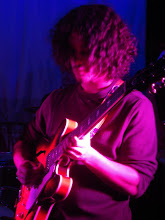The fun continues with triads in closed position. Try this line out with your second finger on the 8th fret:

As you can see this line contains a C triad followed by B dim in second inversion which leads into A min triad in 2nd inversion. This line still uses cycle 2, but uses different inversions and octave displacements to create a really cool and different texture.
This is a hard line to sing and hear because although there is a thought process and underlying logic to the line it contains a very strange mix of intervals and avoids enclosing leaps. It’s debatable whether or not anyone who didn’t already know what it is would hear some kind of pattern. But isn’t that the point? To take a mechanical exercise and learn to weave the movements and reflexes it builds up in our ears, hands and minds into new sounds which don’t sound mechanical?
What I do know is that I like the sound of this sort of thing and that eventually if I sing it enough I’m sure it will greatly improve my ability to play with increasing intervallic complexity. Why is it that up until now that triadic sounds or series of triadic sounds in my single note playing have almost always been in root position and in the case of sequences and patterns, ALWAYS the same inversion. There really is no reason to continue being limited by this constraint.

No comments:
Post a Comment